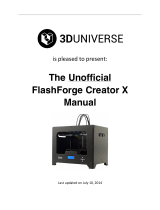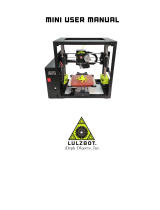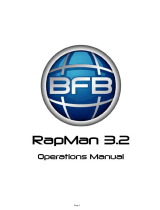
MAKERBOT METHOD MANUAL PAGE 16
to select it.
Insert your USB drive into the USB port to the right of the power button. Use the touch screen to click “Update Now” to
proceed to the next step. Select the file for the firmware that you downloaded and installed on your USB drive. Your MakerBot
Method should begin downloading and installing the selected firmware. Once the firmware has been successfully updated,
you will be all set to continue the setup process for your MakerBot Method. Select “Continue Setup”, followed by “Begin Setup”
on the next screen.
NAMING YOUR PRINTER
Once you have updated to the latest firmware you will be prompted to change the name of your MakerBot Method as the next
step in the setup process. On the next page, you can use the touchscreen keyboard to enter a name for your MakerBot Method.
This is a helpful feature to help dierentiate multiple printers. If you would like to skip this step of the setup process, you can
press the “X” in the top le corner of the screen.
SIGNING INTO YOUR MAKERBOT ACCOUNT
Logging into your MakerBot account on your MakerBot Method will ensure the best experience within the MakerBot ecosystem
and will automatically register your MakerBot Method. Your MakerBot Account is the account that you use to log into
MakerBot.com and MakerBot Print. If you do not have an account, visit https://accounts.makerbot.com to create one.
INSTALLING THE PERFORMANCE EXTRUDERS
It is strongly recommended you install the Performance Extruders as part of the guided setup. If you skip this step, you will
need to attach the extruders through the interface later in order to calibrate, load material, and print. If you would like to skip
this step, press the “X” in the top le corner of the touch screen. Clicking “Skip Printer Setup” on the pop up will skip this step
and end the Startup Process.
LEVEL BUILD PLATFORM
Aer installing the Performance Extruders the next step in setting up your MakerBot Method is to ensure that the build
platform is level. The spring steel should not be in place for the leveling check. If you have installed it from your customer
kit already, please remove it. Your MakerBot Method will now check to ensure that the build platform is level. To do this, the
printer will move the extruders around the build area and have the built in sensor check the build platform height at 3 locations.
This may take a few minutes. If your build plate is not level (most likely shied during shipment) you will be taken through the
assisted leveling procedure.
CALIBRATION
Once your you have ensured that the build platform on your MakerBot Method is level you will need to calibrate the extruders.
When printing with Method’s two Performance Extruders, it is crucial to ensure the distance between both extruders is set
correctly. If the extruders are not calibrated, a part may not print successfully. The first step of the calibration process involves
the extruder nozzles locating their X, Y and Z positions by probing the holes in the build platform. In order for them to be able
to access the build platform, the build plate can not be installed. If the build plate has been installed, open the door, remove it
and close the door before proceeding.
CLEANING THE EXTRUDERS
It is very important for the calibration process that the extruder nozzles are clear of any material. New extruders should be
clean, but may have some filament le on or in them from the testing process. Inspect the nozzles on your extruders for any
material. If you see any filament click “Clean Extruders” to go through the extruder cleaning process. Ensure there is no debris
in the square indents in the build platform as this can also interfere with the calibration process. If there is debris, use canned
air or another method to blow it out. If there is no material on the extruders and the indents are clear, click “Skip” to begin the
calibration process.
BUILD PLATE CALIBRATION
Once the calibration of the build platform has been completed. The MakerBot Method will need to determine the height of
the build plate. Remove the Spring Steel Build Plate from your Starter Kit, open the door of your MakerBot Method and insert
the build plate fully into the build platform. The easiest way to insert the build plate properly is to angle it at 45 degrees, seat
the back of the build plate into the back notches on the build platform and then to lower the rest of the build plate into place.
Double check that the build plate is fully seated on the build platform (no space in the back) and click “Done” to continue. The
screen will update once the final calibration phase is complete.
LOADING THE MATERIALS
Follow the onscreen instructions to load the spool and material into your MakerBot Method.
MATERIAL BEST PRACTICES
LOADING TIPS
Before loading your materials it is important to remove about 2 feet from the spool before inserting it into the slot in the drawer.
Any materials that may be bent or crimped may get stuck or break along the way to the extruder.
























